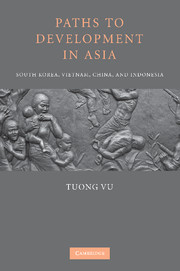Book contents
- Frontmatter
- Contents
- List of Tables and Figure
- Acknowledgments
- List of Abbreviations
- 1 State Formation Dynamics and Developmental Outcomes
- PART ONE DIVERGENT NATIONAL PATHS OF STATE DEVELOPMENT
- PART TWO VARIANTS OF ACCOMMODATION: VIETNAM AND INDONESIA COMPARED
- 6 Organizing Accommodation in Vietnam: Coalition Government, United Front, and Leninist Party
- 7 Organizing Accommodation in Indonesia: Parliament and Status-Based Parties
- 8 Talking Accommodation in Vietnam: Nation, the People, and Class Struggle
- 9 Talking Accommodation in Indonesia: Nation, the People, God, and Karl Marx
- 10 Rethinking Developmental States
- References
- Index
7 - Organizing Accommodation in Indonesia: Parliament and Status-Based Parties
Published online by Cambridge University Press: 04 August 2010
- Frontmatter
- Contents
- List of Tables and Figure
- Acknowledgments
- List of Abbreviations
- 1 State Formation Dynamics and Developmental Outcomes
- PART ONE DIVERGENT NATIONAL PATHS OF STATE DEVELOPMENT
- PART TWO VARIANTS OF ACCOMMODATION: VIETNAM AND INDONESIA COMPARED
- 6 Organizing Accommodation in Vietnam: Coalition Government, United Front, and Leninist Party
- 7 Organizing Accommodation in Indonesia: Parliament and Status-Based Parties
- 8 Talking Accommodation in Vietnam: Nation, the People, and Class Struggle
- 9 Talking Accommodation in Indonesia: Nation, the People, God, and Karl Marx
- 10 Rethinking Developmental States
- References
- Index
Summary
The broadcast of the Japanese emperor's announcement reached Indonesia at noon on August 15, 1945. The news of Japan's surrender came as a shock to those native nationalists who had collaborated with Japan (Anderson 1972, 66–9). The transfer of power from Japan to Indonesia was about to be arranged, and these Indonesian leaders expected to have a few months afterward to consolidate their government before Japan's eventual defeat. In the previous months, Sukarno, Mohammad Hatta, and others had agreed to a draft national constitution by which a presidential system would be established, based roughly on the Japanese-created administration on Java. This system would have a strong executive who would lead a state party and be advised by agencies set up by the Japanese. In other words, if things had gone as planned, especially if Sukarno had not been later sidelined, there was some chance that Indonesia may have a centralized and cohesive state structure in the mold of militarist Japan.
Japan's surrender meant that no legal transfer of power would happen. It also meant that the Allies and the Dutch would arrive in Indonesia sooner than expected. Yet, after Sukarno and Hatta's proclamation of independence on August 17, it did not yet appear that Indonesia would be destined to have a state with a fragile structure. Despite numerous local uprisings, Indonesian leaders went ahead as planned and set up a government with power centered in the presidency.
- Type
- Chapter
- Information
- Paths to Development in AsiaSouth Korea, Vietnam, China, and Indonesia, pp. 157 - 179Publisher: Cambridge University PressPrint publication year: 2010

